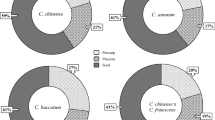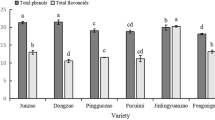Abstract
WORK on the chemical composition of the various parts of fruit trees, particularly apple and pear, is proceeding at Long Ashton aud East Malling Research Stations and the Ditton Laboratory. The problems being studied are not quite the same in each laboratory, but discussions of common interests have disclosed certain overlapping findings. For this reason, we wish jointly to report the presence of chlorogenic acid in both mature and immature apple and pear fruits, and of this substance and a substance similar to, or identical with, isochlorogenic acid of coffee1 in leaves and shoots of pear.
This is a preview of subscription content, access via your institution
Access options
Subscribe to this journal
Receive 51 print issues and online access
$199.00 per year
only $3.90 per issue
Buy this article
- Purchase on Springer Link
- Instant access to full article PDF
Prices may be subject to local taxes which are calculated during checkout
Similar content being viewed by others
References
Barnes, Feldman and White, J. Amer. Chem. Soc., 72, 4178 (1950).
Author information
Authors and Affiliations
Rights and permissions
About this article
Cite this article
BRADFIELD, A., FLOOD, A., HULME, A. et al. Chlorogenic Acids in Fruit Trees. Nature 170, 168–169 (1952). https://doi.org/10.1038/170168b0
Issue Date:
DOI: https://doi.org/10.1038/170168b0
This article is cited by
-
Die phenolischen Inhaltsstoffe des Obstes
Zeitschrift f�r Lebensmittel-Untersuchung und -Forschung (1973)
-
�ber das Vorkommen von Kaffees�ure und Chlorogens�ure im Obst und Gem�se
Die Naturwissenschaften (1956)
-
Phenolic Substances of Pear – Apple Hybrids
Nature (1955)
-
Significance of the Ratio between the Water-soluble Aromatic and Nitrogen Constituents of Apple and Pear in the Host-Parasite Relationships of Venturia Species
Nature (1954)
-
Chlorogenic Acid and the Enzymic Browning of Apples and Pears
Nature (1953)
Comments
By submitting a comment you agree to abide by our Terms and Community Guidelines. If you find something abusive or that does not comply with our terms or guidelines please flag it as inappropriate.



